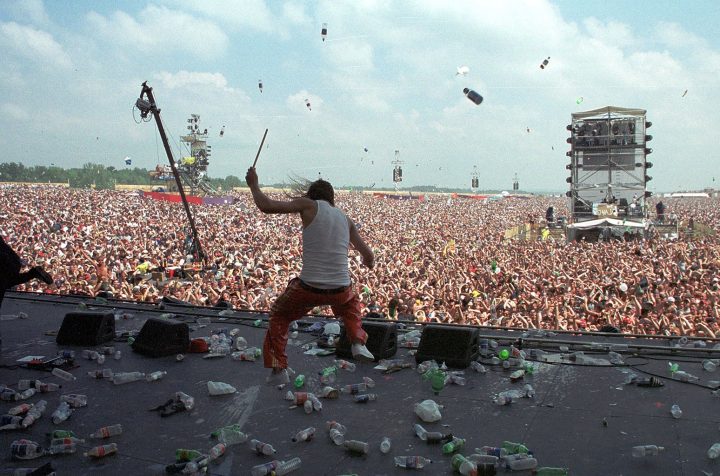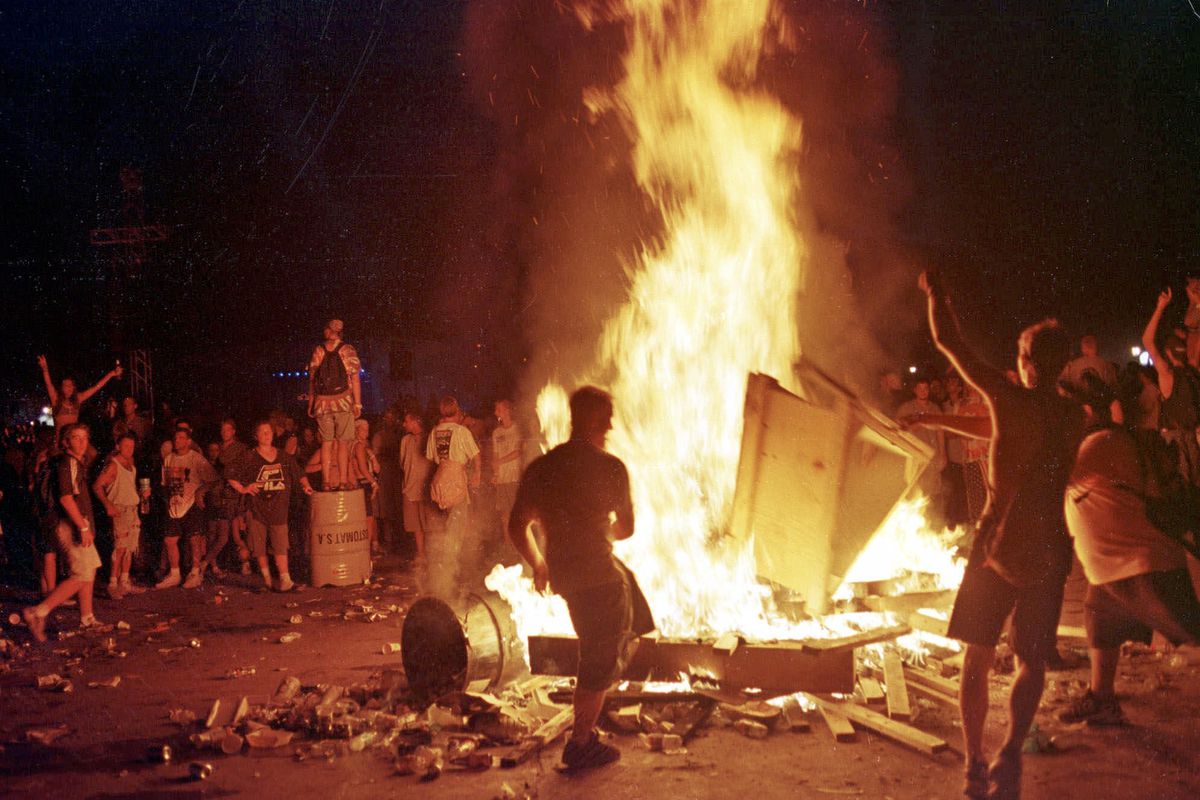
The 1999 revival of the Woodstock music festival is generally remembered in one of two ways: either as a cultural novelty (“Can you believe they tried to do another Woodstock on an Air Force base with a bunch of nu-metal and butt rock bands?”) or a teenybopper Apocalypse Now, representing the most violent and toxic impulses of the era, marred by rampant violence, arson, sexual assault, looting, and more. Garrett Price’s Woodstock 99: Peace, Love, and Rage — the first installment in HBO and The Ringer’s docuseries Music Box — falls squarely in the second camp, portraying the misbegotten and mismanaged festival as something like the Altamont of Generation X. In its lens, Woodstock ’99 was not merely a musical event that went tragically awry, but a defining allegory for the Y2K era and a harbinger of things to come.
At its best, Peace, Love, and Rage is critically engaged with how the memory of each Woodstock festival is inseparable from its media depictions. The original 1969 Woodstock has developed a mythic aura in large part thanks to the iconic documentary that captured it, while the Woodstock ’99 MTV broadcast and pay-per-view focused on the hostile atmosphere and heavy female nudity. The strongest moments utilize concert footage, featuring performers like Dexter Holland of the Offspring or Rosie Perez calling out disgusting crowd behavior, or the extremely combative and hostile press conferences. But like so many other recent music documentaries, the film drowns out that archival material with as many credentialed experts and famous talking heads as possible instead of letting it speak for itself. At times it’s like a slideshow of buzzwords and topical issues — Columbine, Fight Club, white male privilege, etc. It’s hard not to detect some hypocrisy here, such as how the film criticizes the Woodstock cameramen fawning over women’s naked bodies while showing an enormous amount of uncensored footage of those same women. Not to mention how it presents Moby, who is no stranger to sexual harassment, as a mouthpiece for respectful male feminism.

This isn’t the first documentary about Woodstock ’99. Though it’s now unfortunately hard to come by, Barbara Kopple’s My Generation (2000) entrenched itself with music promoters during the ’94 and ’99 Woodstock revivals, ultimately finding more in common than not between the different festivals. It feels very much of the No Logo era, and is more about Baby Boomers selling out and the commercialization of experience than attempting to link music trends to societal ills. By spending considerably more time observing the planning behind the scenes, the film makes it clear that the blame for the problems of Woodstock ’99 falls squarely on the money-hungry ex-hippies who wanted to make a mint off their glory days. Kopple damningly cuts between promoter Michael Lang in the ’60s, talking about how the money doesn’t matter, and present-day Lang cutting deals with Häagen-Daaz and approving an ad that says “Woodstock ’94: Love and Pepsi.” Kopple also highlights a genuinely political and engaged youth counterculture, in sharp contrast to the apathy and mindless aggression depicted in Peace, Love, and Rage. We hear disdain and skepticism toward the image of Woodstock from the young people, and even from performers like Henry Rollins and Trent Reznor. Instead of the spooky horror movie music Price uses, Kopple soundtracks footage of the fires and riots with attendees saying things like “There’s a reason nobody touched the nonprofit tent.”
You can feel the creeping influence of Francis Fukuyama’s The End of History and the Last Man on Peace, Love, and Rage. That defining text of the 1990s brashly asserted that since liberal capitalist democracy had achieved global supremacy, the rest of history would be a kind of static plateau. The doc sees the attendees as raging not against a very real machine, but rather their feelings of political purposelessness. But My Generation makes it clear that many of the kids were in fact rioting to get the food, water, and supplies they’d been denied and price-gouged on. It’s hard not to diagnose this renewed nostalgia for the ’90s as a specifically post-Trump phenomenon; many have convinced themselves that the Big Bad has been defeated, and now nothing is left to do but return to “normal,” just as many mistakenly felt at the end of the 20th century.

As Vulture’s Craig Jenkins points out, there are a number of useful contextualizing details about the music industry that would have painted a very different picture if the film had included them. Contemporaneous events like Ozzfest featured even more heavy metal without any violence or controversy, and accidental deaths, sexual assault, and crowd control were and continue to be serious issues at major festivals. Woodstock ’94 might have had less human waste and fewer calls to break stuff, but it was also an over-commercialized, overcrowded mess with mud pits and broken fences. You wouldn’t know this from Peace, Love, and Rage, which makes that event seem like a well-organized frolic in the hills. The short sequence dedicated to ’94 is set to the Cranberries’ “Dreams,” a deliberate counterpoint to the “hyper-masculine” likes of “Freak on a Leash” and “The Kids Aren’t Alright” (in reality, just like its predecessor, ’99 featured as many jam bands as hard rock acts).
The film ends by comparing Woodstock ’99 to Coachella, somehow mistaking the granddaddy of all hyper-corporate music festivals as a more enlightened alternative. If anything, Peace, Love, and Rage proves that the promoters of the event replicated the original festival better than they ever could have imagined. Now both Woodstocks ’69 and ’99 are invoked as overdetermined, overgeneralized metaphors for the times in which they happened. Price’s documentary notes the irony that Megadeth’s “Peace Sells” was the last song performed at Woodstock ’99, but nobody there was actually selling peace; just Pepsi.
Woodstock 99: Peace, Love, and Rage is available to stream on HBO Max.
0 Commentaires